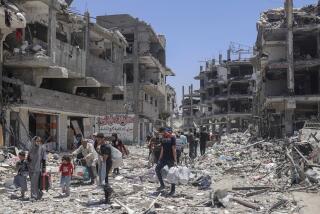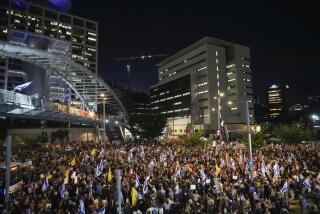U.S. Pursues Quiet Progress on Mideast Peace Plan
WASHINGTON — With the White House visits by Palestinian and Israeli leaders now over, the United States hopes to generate momentum behind the latest Middle East peace plan by making progress on three pivotal security and political issues over the next few weeks.
But in contrast to the fanfare and summitry surrounding the U.S.-backed “road map” since it was unveiled in April, the key now is quiet progress, to prevent reaction to what may include unpopular decisions by both governments, U.S. officials say.
To end growing tension over a new security fence, the United States has asked Israeli Prime Minister Ariel Sharon to consider modifications that would pull the barrier back from West Bank land or create access in places where Palestinian property is divided and keep future construction to the so-called Green Line that divides Israel from the West Bank, according to U.S. officials.
“The core idea is to ensure no Palestinian land is confiscated,” a senior U.S. official said Thursday.
In consultation with his Cabinet, Sharon has promised to “review” the plans for the barrier and find ways to deal with the “inconvenience and harm” to the local population, an Israeli diplomat said Thursday.
President Bush last week said he had problems with the barrier. But in their meeting here Tuesday, Bush was unable to get Sharon to agree to either dismantle existing segments or halt future construction. Instead, U.S. and Israeli officials say, they are trying to find compromises that minimize civilian suffering.
Israel announced Thursday that the first section of the 370-mile barrier has been completed. The second section of what Israelis call a “fence” and Palestinians label a “wall of separation” is due to be finished by year’s end.
“Concluding the fence is a matter of many months. It’s very long, and there’s a lot of money involved,” said Zalman Shoval, a former Israeli ambassador to the U.S. “Practical ways can be found for Palestinian landowners and farmers to go through agreed-on gates and openings.”
Washington also is pressing the Palestinians to make the opening moves against militants, steps such as passing laws that would make it illegal to carry weapons in public and dismantling workshops where militants are allegedly now enhancing the range of their rockets to target Israeli cities.
Israel has told the United States that these Palestinian measures are critical to creating an environment in which Israel can make concessions on the fence, the Israeli and U.S. sources added.
“We’re grateful for the current quiet, but the whole process of the road map is still hostage to a terrorist capability that has yet to be challenged,” said an Israeli spokesman, speaking on condition of anonymity. “We know the cease-fire is being used to rearm and rebuild.”
To strengthen the Palestinian Authority’s ability to act, the United States wants Jordan and Egypt to provide more trainers and training programs for a new Palestinian security force, the key to confronting Islamic extremists and other militants opposed to the peace process.
To bolster the new government’s standing, Washington is also prepared to provide additional funding if the Palestinian Authority completely allocates the recent $20 million in U.S. aid for reconstruction and development.
Bolstering the popularity of Prime Minister Mahmoud Abbas is considered a key to the peace plan’s success.
“We’re looking at additional transfers to the Palestinian Authority for agricultural and small-business loans, repairing clinics and hospitals and courthouses, and rebuilding other aspects of the Palestinian infrastructure,” said a senior State Department official.
The Bush administration hopes to keep much of the action off public radar screens.
“Now we’re going to try to make quiet progress on the ground and accomplish things in a way that doesn’t trigger new controversies or violence that would put the process in jeopardy,” the State Department official said.
“Progress out of sight would not be a bad thing right now. It may not give the press much to write about, but it helps with our agenda.”
None of the proposed steps will be easy. And new problems are already generating ill will.
In a setback Thursday, talks between Israel and the Palestinians failed to win agreement on withdrawing troops from two more West Bank cities and turning control back to the Palestinians. A Palestinian spokesman cited a “large gap” between the two sides.
Israel proposed returning Jericho and Kalkilya, while the Palestinians pressed for Ramallah, the West Bank headquarters of Palestinian Authority President Yasser Arafat.
Israel also issued a tender to build 22 houses in Neve Dekalim, the largest Jewish settlement in the Gaza Strip, in defiance of the peace plan’s call for a freeze in settlements and any so-called natural growth.
The State Department publicly chided Israel with a reminder that the peace plan calls for a freeze on expansion of all Jewish settlements in Palestinian-held areas.
On the same day that Sharon returned from his U.S. trip, new talks were already underway “to make sure that we have a common understanding that a freeze is a freeze. And it’s not a freeze that results in continued expansion or growth,” department spokesman Richard Boucher told reporters.
An Israeli diplomat suggested Thursday that the tender might be withdrawn.
But bubbling tensions were reflected in a Palestinian demonstration Thursday against the new security fence that divides the West Bank from Israel.
Protesters in Kalkilya pelted the concrete wall with balloons filled with green, red, black and white paint -- the colors of the Palestinian flag -- and put up a banner describing the fence as an “apartheid wall,” a reference to South Africa’s former system of racial segregation.
*
Times staff writer Laura King in Jerusalem contributed to this report.
More to Read
Sign up for Essential California
The most important California stories and recommendations in your inbox every morning.
You may occasionally receive promotional content from the Los Angeles Times.










